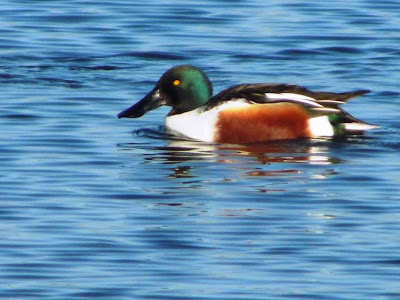I was lucky to get very close to one of the trees cormorants like to perch in and this resulted in a photo I'm really pleased with.
The UK has an internationally important wintering population of these birds, some 41,000 birds1.Unlike other birds they are not too particular about their habitat and will happily go to freshwater lakes like at Blashford, estuaries or the coast- anywhere with a good supply of fish is OK with them.
I also saw a few of what is becoming my favorite waterfowl, shovelers.
These birds are so odd-looking. Females look much like female mallard only with an enormous bill whereas males have a beautiful green head. They use their remarkable bill to forage for aquatic invertebrates2. The bill has 'lamellae' on the edge which are comb-like structures that act as sieves- this allows the birds to skim invertebrates from the water's surface. This adaptation means they don't have to compete with food resources with other ducks.
Again the UK is an important place for these birds as 20% of North West Europe's population call it home3.
Another spot was this lovely little grebe.
Little Grebes are superb swimmers and pursue fish and invertebrates underwater up to a depth of one metre4. They are buoyant due to not having a tail and reappear from dives like a cork. Like other grebes though they are not good at walking and nest right at the water's edge for this reason.
It's not all waterfowl at Blashford of course- I also spotted this green woodpecker.
This bird was almost certainly feeding on ants here, which take up the vast majority of their diet5. It probes it's long beak into the ground and licks up ants and their larvae. Their tongues are long, about 10cm- so long in fact that they have to wrap around the skull in order to fit in the head6!
Moving elsewhere, I spotted a pair of goosander when I was walking past the River Avon this week.
These birds use their long serrated bills to catch fish- they especially like trout and salmon7. They also have been known to eat virtually any other aquatic creatures they can find from molluscs, crustaceans, insect larvae and amphibians to small mammals and birds on occasion8.
When walking in the New Forest this week, I came across a sizeable herd of fallow deer which included one white individual.
Normally fallow deer are light brown and spotty but they coat does darken in the winter. Even so, you would normally expect to see pale spots on these deer but this does vary between populations. It's only the distinctive tails that tell me these are definitely fallow deer.
You might imagine the white deer to be an albino but actually white is fairly common in deer as it's simply natural variation9. I suppose it's similar to humans having ginger hair in that it's a less common variation but a still a relatively high proportion of individuals have it.
That's all for today but I hope you have a good Christmas and I'll be back next week with my end of year round-up.
5: RSPB: Green Woodpecker
6: Robinson, R.A. "Green Woodpecker" BirdFacts. BTO
7: RSPB: Goosander
8: del Hoyo, J. Elliott, A, Sargatal, J (eds) (1992) Handbook of the Birds of the World Vol 1. Barcelona: Lynx Edicions. pp. 626
9: BDS: Fallow Deer










No comments:
Post a Comment